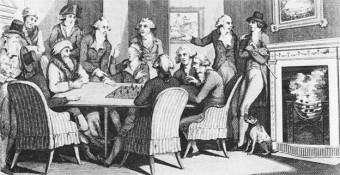François-André Danican Philidor and Blindfold Chess
 In 1744 at the age of 18, François-André Danican Philidor (1726-1795) enthralled Parisian society after playing two simultaneous games of chess in a public demonstration, all while blindfolded. And even though he lost one game and only drew the other, the display established Philidor as a chess master par excellence, and blew new life into the ancient practice of blindfold chess.
In 1744 at the age of 18, François-André Danican Philidor (1726-1795) enthralled Parisian society after playing two simultaneous games of chess in a public demonstration, all while blindfolded. And even though he lost one game and only drew the other, the display established Philidor as a chess master par excellence, and blew new life into the ancient practice of blindfold chess.
Calling Philidor’s 1744 exhibition “one of the most extraordinary examples of the power of memory and imagination,” his contemporary, Jean d’Alembert, the Chevalier de Jaucourt, revealed just how much of the history of blindfold chess had been forgotten.
In the 8th century in the Middle East, Sa’id bin Jubair (665-714 AD) became the first player in recorded history to turn his back on the board while playing, and his contemporary, Muhammad bin Sirin, also enjoyed the challenge of playing without looking. As chess was considered mukarrah (disapproved of) under Muslim law at that time, one observer described practioners of blindfold chess as being “in league with the devil.”
In the 13th century in Florence, Buzecca (also sometimes called Borzaga or Buchecha) played three of the city-state’s best chess players, simultaneously, although he was blindfolded for only two of the games (he won two of them and drew the third). While this probably wasn’t really the first time this happened, it is the first documented instance of a single player holding concurrent, blindfolded matches.
Blindfold chess was apparently widespread in the Arabic world, and there were reports in the 14th century of a blind player, “Ala’addin,” who dominated the game among the nobility in Egypt. Another blindfolded player, named an-Nizam al-‘Ajami was reported to also play multiple, blindfolded, simultaneous games, albeit in Damascus. By the 16th century, reports indicated that there were many Arabian players who could manage an astounding five blindfolded, concurrent matches, though specific documented instances of this are difficult to come by.
However, none of this significantly lessens Philidor’s achievement (you try playing one game blindfolded), and certainly his contemporaries were impressed, and many who didn’t witness it themselves disbelieving. Luminaries like Benjamin Franklin, Jean-Jacques Rousseau and Voltaire wanted to play him, and by 1747, he had moved to London where he played chess professionally, beating England’s top players.
At his peak, he is generally considered to have been the greatest chess player in the world and that peak lasted quite some time. As modern day chess Grandmaster Andrew Soltis noted of Philidor, “[he] was the best player in the world for 50 years. In fact, he was probably about 200 rating points better than anyone else yet alive—set apart by the mysteries of the game he had solved.”
In 1748, he wrote the L’analyse du je des Eschecs (Analysis of the Game of Chess) (published in 1749) in which he penned the famous line, “les pions sont l’ame due jue” (“the pawns are the soul of chess.”)
This motto was in direct contrast to popular strategies of the day. As chess Grandmaster Boris Alterman noted,
500 years ago chess was different from today. Pawns didn’t cost as much as they do today. The best players started games with the gambits. Pawns were only a small price to: Open a file or diagonal; Create an immediate attack on an opponent’s king. It was the Italian style of chess. All positions of the King’s Gambit were very popular…
In addition to giving us the classic line, Philidor’s Analysis is widely hailed as the first book on chess to provide detailed notes on playing the middle game, to present chess strategy as a whole, and for the ideas of prophylaxis, sacrifice, blockade and the “mobility of the pawn formation.”
 Philidor continued to play blindfolded chess games, including beating three players in simultaneous games in Berlin in 1750, and drawing one and losing one during concurrent matches at Parsloe’s Chess Club in London on May 27, 1782. The following year, on May 9, Philidor won two and drew one of three simultaneous blindfold games, also played in London. (During this particular one, affidavits were signed by the opposing players, as it was thought by those players that nobody would later believe this had really happened.)
Philidor continued to play blindfolded chess games, including beating three players in simultaneous games in Berlin in 1750, and drawing one and losing one during concurrent matches at Parsloe’s Chess Club in London on May 27, 1782. The following year, on May 9, Philidor won two and drew one of three simultaneous blindfold games, also played in London. (During this particular one, affidavits were signed by the opposing players, as it was thought by those players that nobody would later believe this had really happened.)
His last known blindfolded match, on June 20, 1795, was also played at Parsloe’s where two were held with the blindfold, and the third with sight; it’s not clear today how those matches played out. Philidor died on August 31, 1795.
If you liked this article, you might also enjoy our new popular podcast, The BrainFood Show (iTunes, Spotify, Google Play Music, Feed), as well as:
- Why the Monopoly Player Pieces (Thimble, Top Hat, Etc.) are What They Are
- Why do Golfers Yell “Fore,” When was the Mulligan First Used, and Other Questions You Might Have Wondered About Golf
- 150 Years in a Jar- The Story of John Dalton’s Eyeballs
- Was Beethoven Really Deaf When He Wrote All His Music?
- That Time Bert Trautmann Played in a Professional Soccer Game with a Broken Neck
Bonus Facts:
- In 1858, at the age of 21, Louisiana native Paul Morphy defeated eight players simultaneously, while playing effectively blind to the boards. Held in the Café de la Regence in Paris, Morphy sat in one room, staring at a bare wall, while the eight players and chess boards were in another. The players even had advisers to assist. After the display, however, Morphy developed a deep aversion to chess, and eventually fell into paranoia, delusion and madness. He died of a stroke in 1884.
- Throughout the 20th century, new records for blindfold chess were set and broken. Harry Nelson Pillsbury played 20 blindfold games concurrently in 1900, and in 1924, Alexander Alekhine played 26 difficult opponents, winning 16, losing 5 and drawing 5, in what has been characterized as the strongest exhibition of blindfold play ever held.
- Alekhine went on to set another record in 1934, with 32 games, which George Koltanowski broke in 1937, when he played 34 simultaneously.
- There is a dispute about the next records, with some claiming they were not properly monitored. For example, Miguel Najdorf (1947) played 45 opponents, winning 39, drawing, 4 and losing two. Likewise, in 1960, János Flesch played 52 opponents, winning 31, losing 18 and drawing 3.
- In November 2011, Marc Lang broke the universally accepted record (34) when he played an astounding 46 concurrent blindfold matches, winning 25, drawing 19 and losing 2.
- Philidor was also a musical prodigy, and over his life he composed 21 music-comedies and one opera.
- Analysis of the Game of Chess
- Blindfold Chess
- Blindfold Chess
- Blindfold Chess
- A chess champion’s dominance and madness
- François-André Danican Philidor
- François-André Danican Philidor
- Philidor
- Sa’id bin Jubair: The Blindfold Master of Chess
- The Second Career of François-André Danican Philidor
- What was Philidor Thinking?
- Image Source
| Share the Knowledge! |
|





Derren Brown, and probably lots of other mentalists, have done this sort of thing too. The increasing numbers of boards needn’t mean increasing mental effort.
Make sure you play alternately black and white down a line and effectively you can make each player play the player next in line, all you’re doing is making player 1’s opening on player 2’s board, 2 on 3’s and so on. The person playing all the games is in effect playing none and doesn’t have to hold anything in his or her mind except the last move made.
Of course, when Derren did it, he didn’t make it quite so obvious. He played 1 against 4, 2 against 5 and so on – as the person at the immediately adjacent table might well notice the mirror of his or her own game going on.
Superb idea !!!